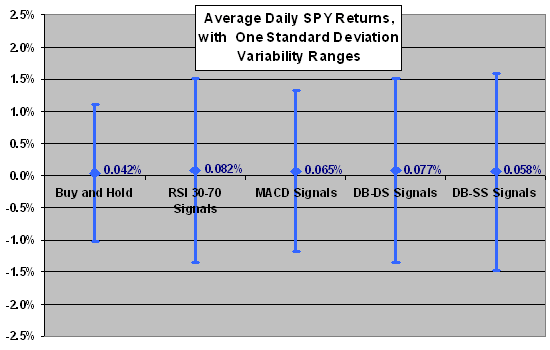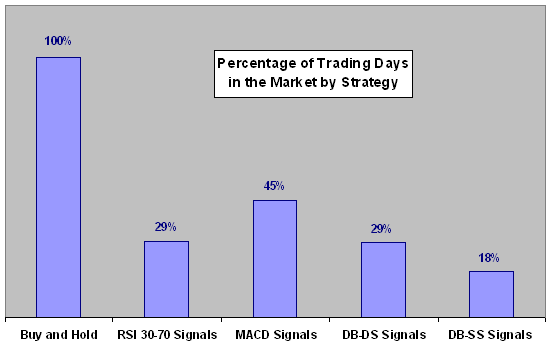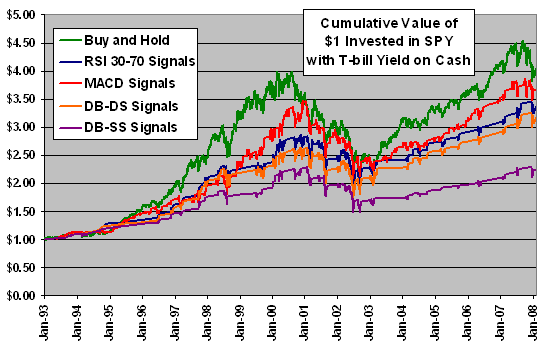Here is a simple test of the usefulness of the Relative Strength Index (RSI) and the Moving Average Convergence/Divergence (MACD), combined, in search of more concentrated abnormal returns. Using those signals and daily dividend-adjusted SPY closing prices from 1/29/93 (the earliest available) through 2/29/08, we find that:
We consider two strategies.
Strategy DB-DS, based on double-buy and double-sell signals:
- Buy SPY at the close on the first date for which both RSI and MACD (as specified in the prior blog entries) signal “Buy.”
- Sell SPY at the close on the next date for which both RSI and MACD signal “Sell.”
- Repeat these two steps across the entire sample.
- Whenever out of SPY, assume a daily return on cash equal to the contemporaneous 90-day Treasury bill (T-bill) yield.
- Ignore trading fees/frictions (since there are on average only a couple of transactions per year).
Strategy DB-SS, based on double-buy and single-sell signals, is identical except for Step 2. This strategy more fearfully exits SPY at the close on the next date for which either RSI or MACD signals “Sell.”
Strategy DB-DS generates 66 transactions (33 round trips) over the entire sample period, an average of about two round trips per year. The 33 round trips produce 26 gains (with the largest 12.5% in late 1997) and only seven losses (with the largest -13.9% in mid-2002). The average gain for all 33 round-trip trades is 2.4%.
Strategy DB-SS generates 74 transactions (37 round trips) over the entire sample period, still an average of about two round trips per year. The 37 round trips produce 26 gains (with the largest 8.0% in late 1997) and 11 losses (with the largest -12.8% in mid-2002). The average gain for all 37 round-trip trades is 1.0%.
The following chart summarizes the average daily SPY returns and variabilities for five strategies while they are in stocks:
- Buy and Hold (for all trading days in the sample)
- RSI 30-70 Signals (for trading days in the market based only on RSI oversold/overbought signals)
- MACD Signals (for trading days in the market based only on previously calculated MACD signals)
- DB-DS Signals (for trading days in the market based on RSI/MACD double-buy and double-sell signals)
- DB-SS Signals (for trading days in the market based on RSI/MACD double-buy and single-sell signals)
Results suggest that combining RSI and MACD signals does not enhance returns. The average daily return while in stocks for the DB-DS strategy falls between those of the RSI strategy and the MACD strategy. The average daily return while in stocks for the DB-SS strategy is lower than both those for the single-signal strategies.
All four signal-based strategies indicate higher than normal daily return volatility while in the market.

The next chart summarizes the percentages of trading days spent in stocks for these same five strategies. Of the 3,799 trading days in the sample, DB-DS transactions put that strategy in SPY 1,104 days (29%) and out of SPY 2,695 days (71%). The DB-SS strategy is in SPY only 677 days (18%) and out of SPY 3,122 days (82%). In general, more restrictive signaling conditions result in less time in stocks.
How do the five strategies compare with respect to standalone cumulative returns?

The final chart plots the cumulative value of $1 initial investments made at the close on 1/29/93 for all five strategies, reflecting both the returns while in stocks and the percentages of trading days spent in stocks. Returns for all strategies include the T-bill yield on cash when out of stocks. The chart shows that the trading strategies underperform buy-and-hold over the sample because: (1) they are often out of stocks; and, (2) even the low return on SPY while the trading strategies are out of stocks beats the T-bill yield. Visual inspection suggests that the trading strategies tend to underperform (outperform) buy-and-hold during bull (bear) market phases, lending them some appeal on an annual risk-adjusted basis. Results are sensitive to the start date of the analysis.
The chart also shows that combined RSI/MACD signals underperform individual RSI or MACD signals. Waiting for “double-buy signals” on SPY, based on this sample, is counterproductive compared to simpler strategies.

In summary, evidence from simple tests indicates that combining RSI and MACD signals probably does not enhance, but instead may degrade, returns from trading a broad market index.